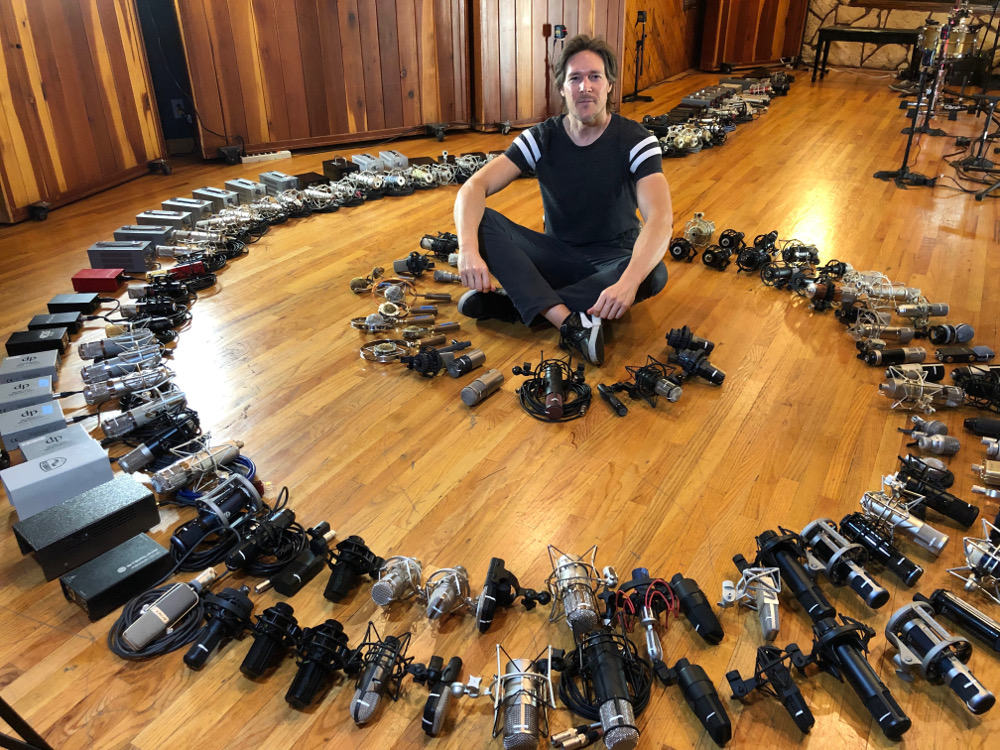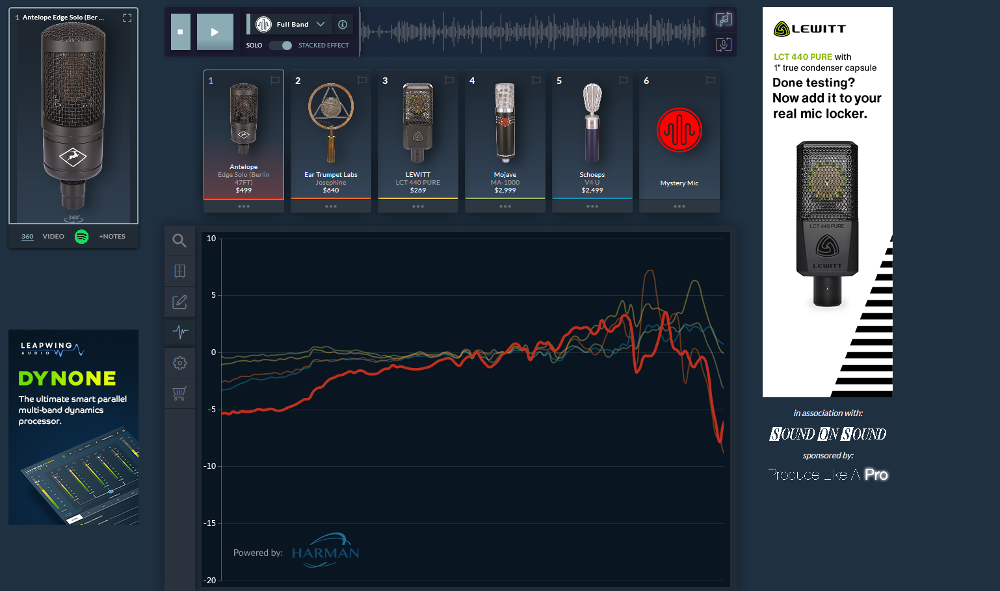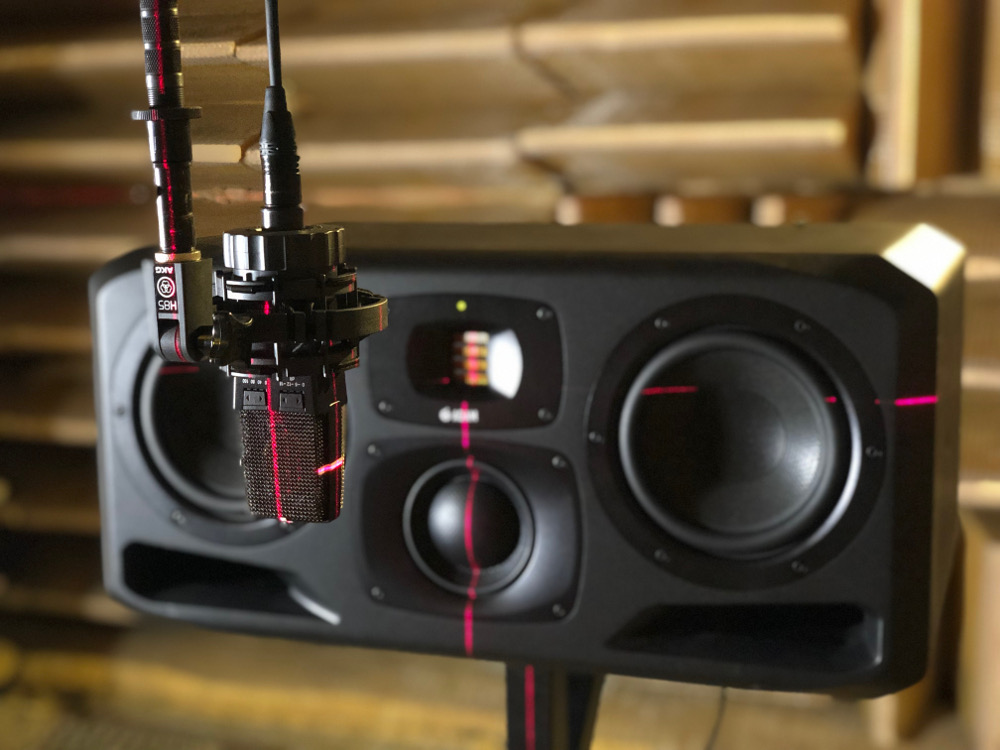A Different Way To Shop for Gear: Audio Test Kitchen Arrives
Is audio retail ready for a sea change?
Well, ready or not, here it comes: Audio Test Kitchen (ATK) has launched. An online audio showroom, it’s cracked the code of how to conveniently audition new microphones in the comfort of your studio—without having them in your studio.
A meticulously engineered comparison engine, ATK is the vision of co-founders Alex Oana and Ian Hlatky. Visitors to the site will find a thoroughly-thought-through mechanism for comparing 250 large diaphragm condenser mics plus 50-and-growing digital mic models (much more gear and instruments to come), within an intuitive interface that allows them to navigate multiple sound sources, frequency response graphs, technical specs, 360° photos and much more.
Engineers out to answer qualitative questions with new levels of efficiency will find an extreme resource in ATK. On the other hand, for those in search of a new rabbit hole promising hours of exploration, ATK is a warren from which they may never escape. Audio pros will almost certainly experience the site as a highly enlightening playground either way, but for Oana, Hlatky and their team, assembling the platform was a massive task. Inspired by Oana’s experiences as a Los Angeles-based sales consultant for Vintage King, as well as serving as Vice President of Creative Operations for sonic innovators Slate Media Technology where as VP of Creative operations he was Co-Designer and Product manager for RAVEN, Audio Test Kitchen set out to do something that had never been done before in audio—but they were certain was needed.
“When I was talking to and helping hundreds of engineers on the phone and through email as a salesperson at Vintage King, both my customers and I were experiencing pain around the same thing,” Oana says, “and that was their need to know what the gear they wanted to buy sounded like before they bought it. Unless they were able to make it to a showroom, they just didn’t have a good way of being able to not only hear that piece of gear, but compare it to the other available choices.
“The pain that I was experiencing was that I felt powerless to help them, because they were asking me to tell them what they should buy based on words we were using, things that we were describing, preferences, taste,” Oana continues. “I would always ask myself, ‘What gives me the right to tell you what you would like? I don’t have your ears. Your ears are your ears, and that’s why there’s all this different gear being made. It’s for different applications and for different preferences.’
“For the entirety of the time that I had to try to help guide someone through the purchase process, I felt like both I, as a salesperson, and my customers were missing an essential piece of information, and that was simply to be able to hear and compare the gear. People want to buy the thing that’s right for them, that’s going to help them meet their artistic goal, but we have always been limited in this process: Either we’re limited by the inventory and the brands in the particular store that we’re in, whether that’s physical or online, or even in the best showroom in the world we’re limited by the options that are available there for us to test and compare.”
In mid-2017, Oana and Hlatky built a team that included Audio Engineers James “Fluff” Harley and Jesse Ray Ernster along with Chief Sales Officer Jeff Ehrenberg to embark on a highly ambitious mission: Create the world’s first virtual pro audio showroom. “In fact, we believe it’s a better-than-showroom-experience because we bring that showroom to your studio where you’re comfortable listening in your environment any time of the day you want,” Oana says. “We’ve torn down the walls of the online retailer and opened it up to every product in the category. Now your exploration, your discovery, and the options available to you are only limited by your interest and what appeals to you.”
The ATK team underwent what would be a two-year process to create an optimal interface–one that would be flexible and intuitive, with the ability to logically present a wide range of information, while also allowing the user to navigate myriad songs, sources and genres.
“We are extremely cognizant of the fact that there’s lots of different types of information required to create this knowing and understanding about what a product can do, and to create the sense of confidence about how that piece of gear might sound if I were to own it myself,” Oana explains.
Making It Work
When a visitor to Audio Test Kitchen arrives at the site, they’re greeted with a one-window interface with deep capabilities.
On top, a player offers up two songs, each one available for listening as a complete mix or as solo instrument tracks including vocals, piano, drums, and guitar. Below that, users can create their own comparison mic “cupboard,” mixing and matching from the 300 mics currently in the ATK collection. Each mic has recorded each source in mechanically repeatable fashion, in a process designed to eliminate discrepancies and create a completely level playing field (more on that below).
A 360-degree display to the left gives ATK users a visual zoom-in on each mic. Frequency charts, tech specs and more are available at the flick of a switch. A well-thought out “Blind Mode” may be one of the most useful functions of all, allowing users to audition their mic selections with all visual identifiers removed to take user bias completely out of the equation.
From an $80 Sterling S150S clear to a $9,990 Sony C800G, users have hundreds of options in an environment where they can easily spend hours listening and comparing. From there, they can support the site by choosing to buy their mic of choice via the shopping cart, which provides affiliate links to various online retailers.
Experiential Problem Solving
For the ATK team, the path to envisioning this fun and sonically satisfying user experience, and then executing on it, involved solving three primary problems.
“First,” Oana says, “we had to figure out what is the best and most essential information that we must present about all this gear, to allow anyone experiencing it online to fully understand, and take away from that experience, what they need to know to make a great decision and feel totally informed and confident.
“Feeding that, we had to figure out what kind of recordings we were going to use–which songs and sources. Then on the scientific level, what kind of methodology are we going to create to make sure that the only differences heard are between those microphones, so there’s no variables from the performances, from the instruments, or from the recordings themselves that would throw a listener off and make a false association about differences they hear when they switch from mic to mic. We had to make sure that when you go from one mic to the next the only difference you hear is between those mics themselves.”
From there, the ATK team had a second issue to address in parallel. “Let’s say you can have all these perfect recordings that fully tell the story of every microphone or every piece of gear,” Oana reasons. “What’s the best way to get that information to people, the best format for experiencing it in an efficient and intuitive way? We had to create an online interface that would make the most of this really robust, scientifically-derived recording data.”
In addition to presenting the microphones’ information — like price and frequency response — in an intuitive way…Oh yeah! They had to physically get their hands on the microphones themselves so that they could be sample recorded and subsequently represented on the site.
“We had to figure out how to acquire all this gear and get the manufacturers to agree to participate,” states Oana. “This was an equally gigantic undertaking. At the end of the road we are totally blown away and impressed with the degree of manufacturer participation and the way that they took on the same spirit with which we started this, which was that this resource is something that the industry really needs.
“We identified about 75 large diaphragm condenser microphone manufacturers in the world. We invited everyone to the table for free, no obligation, no pay-to-play, we just want you to participate. The reaction was overwhelmingly positive. There were a few people who needed a little bit more convincing, but at the end of the day, 53 microphone manufacturers sent us what amounted to three-quarters of a million dollars worth of microphone inventory to test with Audio Test Kitchen.”
Manufacturer Assist
In addition to providing ATK with the microphones themselves, the manufacturers proved to be a key source of know-how for the vocal sample recording process.
“One of the manufacturers told us that in their R&D production process they would record a vocal using a high resolution capture microphone–a laboratory grade measurement mic that would capture a single vocal performance–and then they would reamplify that performance through a loudspeaker,” explains Oana. “That way, as they developed and changed the sound of that microphone that they’re working on they could be 100% sure that the source never changed. From there, any changes that they were tracking were only due to the changes in their tweaking of that particular product.
“That method was a time savings for us, but even more it was a massive leap in the consistency of the library assuring people that there would be no variables when they’re comparing one vocal to the next. It actually was the number one driver behind us forging a partnership with Harmon Labs here in our neighborhood in Northridge, California. We ended up working in their anechoic chambers for over a month, aided by Harman Labs’ research hosts Dr. Sean Olive, Todd Weiti, and Omid Khonsaripour.”
Studio Time
With so many logistics going into the launch of Audio Test Kitchen, the recording of the audio samples posed the most important challenge. For the ATK team, it would prove to be a nonstop series of learning experiences.
“We originally set out to record all ten sources on 250 microphones at EastWest Studios over the course of a two-week period in December of 2018,” Oana says. “We assembled a massive crew of engineers including James “Fluff” Harley, Jesse Ray Ernster, Hunter Lee Alexander, Sébastien Teti, Nick Guadagnoli, Sarah Raz, Jimmy Dixon, Tyler Louis, Matt Wolach, Hoss Yekband, Don Setaro, and Ally Hustings.”
After loading all of the mics into an EastWest lounge, unpacking them and getting them set up, the group got their first procedural gestalt. “We quickly realized that there were some variables that we were not yet good at controlling,” acknowledges Oana. “Despite EastWest Studio 2 being one of the best sounding recording rooms ever conceived, it’s nature is not one of modern, extreme isolation, which is what we would have required in order to record a number of these sources simultaneously with efficiency.
“We ended up coming away from EastWest with a couple of really great takeaways,” he continues. “One was we successfully captured the Yamaha Disklavier self-playing piano that Yamaha loaned us for that period of time, both a close-miking and a room-miking of it in the main live room, and we came away with full recordings of bass amplified on multiple songs and electric guitar being amplified on multiple songs.
“We also came away with a lot more knowledge about our own process and how to do it efficiently and repeatedly. The third thing we walked away with was our failures, how we were not able to control variables and how we needed to be able to go back to the drawing board in a number of senses, especially when it comes to drums. Drums became our albatross and we set out to solve the drum problem over the course of two more studios over the following months. It ended up being incredibly challenging, more than we would have ever thought.”
The signal path for bass, piano and vocal recordings was virtually 100% uniform throughout, employing the Grace Design M108 mic pre/A-D converter for almost all sources, but always identical within a single source. Focusrite Rednet interfaces connected with Pro Tools for analog output duties, recording to the 32-bit/96kHz spec.
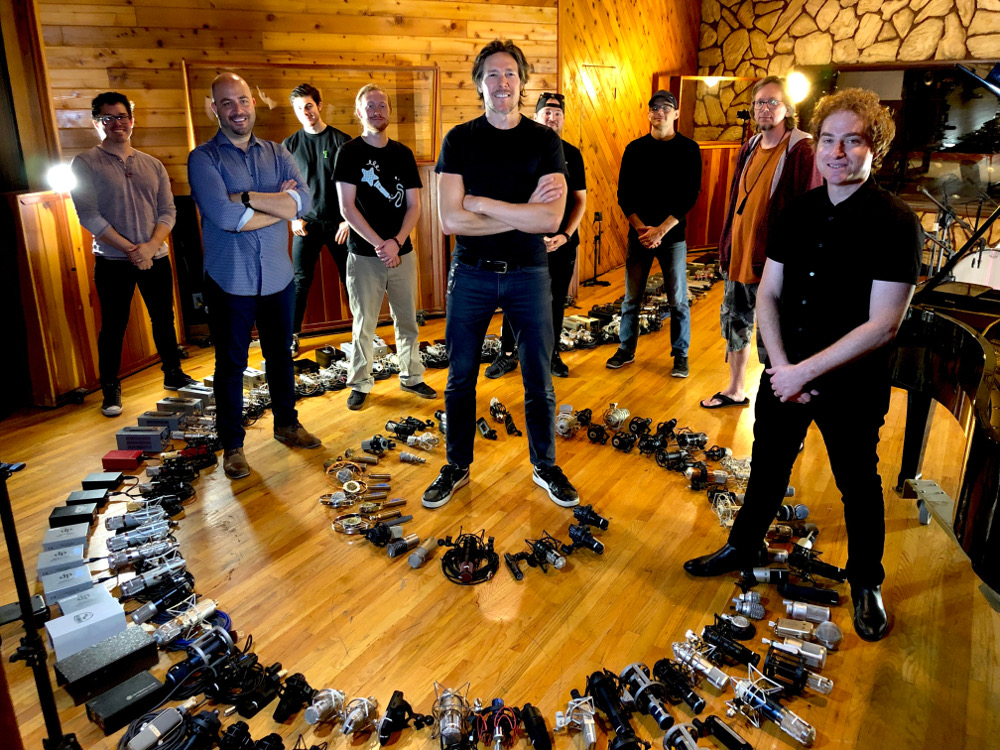
Paying attention to detail: (left-right) The sonic capture team of Adam Allison, ATK Co-founder Ian Hlatky, Johnny Coddaire, Lexicon Groat, ATK Co-founder Alex Oana, Hunter Lee Alexander, Jesse Ray Ernster, James “Fluff” Harley, and CSO Jeff Ehrenberg in Chris Lord-Alge’s Can-Am Studio A, Tarzana, CA.
Ideal Online Listening
When it came to the source files themselves, ATK had to ensure that their resolution and online delivery didn’t get in the way of objective listening.
“It was very important to us to study what was right and what was wrong about existing audio product comparisons and shootouts,” Oana says, “whether those were on YouTube, or done by studios, or manufacturers, or retailers at all kinds of levels, from extremely novice to extremely pro. We kept the best, and we changed what needed to be changed.
“One of the most simple and fundamental things that will throw off the results of an audio product comparison is any difference in level. We had a two-stage level matching process. One was to use our own proprietary test tone calibration system on the front end: Every microphone had its mic pre gain matched within 1dB. Then we closed that gap to one-tenth of a dB gain matching by using a product called Myriad in the final post-production stage, which is simply a high resolution gain-only analysis tool that ensured that every file that was uploaded to Audio Test Kitchen had a perceptual volume match.”
From there, ATK worked to strike the necessary balances for a fluid user experience. “That meant quick download times, quick changes from one microphone to another, quick source changes,” he notes. “We also wanted as much universality as possible. We chose the highest resolution MP3 we could, which is 320kbps.
“Audio Test Kitchen will, in the near future, announce a partnership with an audio development lab of a full-resolution audio codec for use with all our audio samples where we will be able to achieve CD quality at a sub-MP3 data rate. It’s a real breakthrough, and that is coming on the horizon. Not only is it going to be a great user experience, but all the subtle detail that’s in the original source recording is going to be translated and played back perfectly in anyone’s listening environment wherever they are, whether that’s their phone or the studio. As a manufacturer I would feel even better about the idea that all the nuances of my product are going to be properly communicated all the way down to the end listener.”
As an all-new platform, ATK’s team is ready and willing to incorporate user feedback in pursuit of refining the experience. “Right now Audio Test Kitchen provides enough kinds of information for professionals and hobbyists to make confident decisions about what they might want to buy or use in their next session,” says Oana. “We intend to get feedback from some of these early adopters to help make Audio Test Kitchen an even better resource for a broader audience with all levels of skill. We expect that we’ll learn a lot that’s going to help us fine tune the Audio Test Kitchen experience so that it feels intuitive, accessible and a really helpful tool for anybody, no matter their experience level.
“I think these days people expect a lot from technology, and from websites and apps,” he continues. “I think they rightfully should. It’s our job to create the kind of information, whether that’s an audio recording, or a specific kind of music, or specific source, or the way our user interface is designed to help people think through the problem that they’re trying to solve. One way we can do that is by asking them some questions about what they’re looking for and how we can help them right there on the website.”
An Intense Personal Journey
Launching in tandem with AES 2019 in New York City, Audio Test Kitchen has already assembled some high-profile advocates. Advisors and patrons so far include experts such as Phil Wagner, Tony Maserati, Chris Lord-Alge, and Jerimaya Grabher, not to mention a long list of friends who have helped them to get to this point.
While it looks to the world like Audio Test Kitchen is just getting started, for the ATK team the public launch is simply the next leg of a trip that has been longer, stranger and harder than they ever imagined. But despite the stress, doubt, and hours of tedious tasks that came nearly every step of the way, Alex Oana–for his part–has evolved into newfound heights of strength and personal insight as a result.
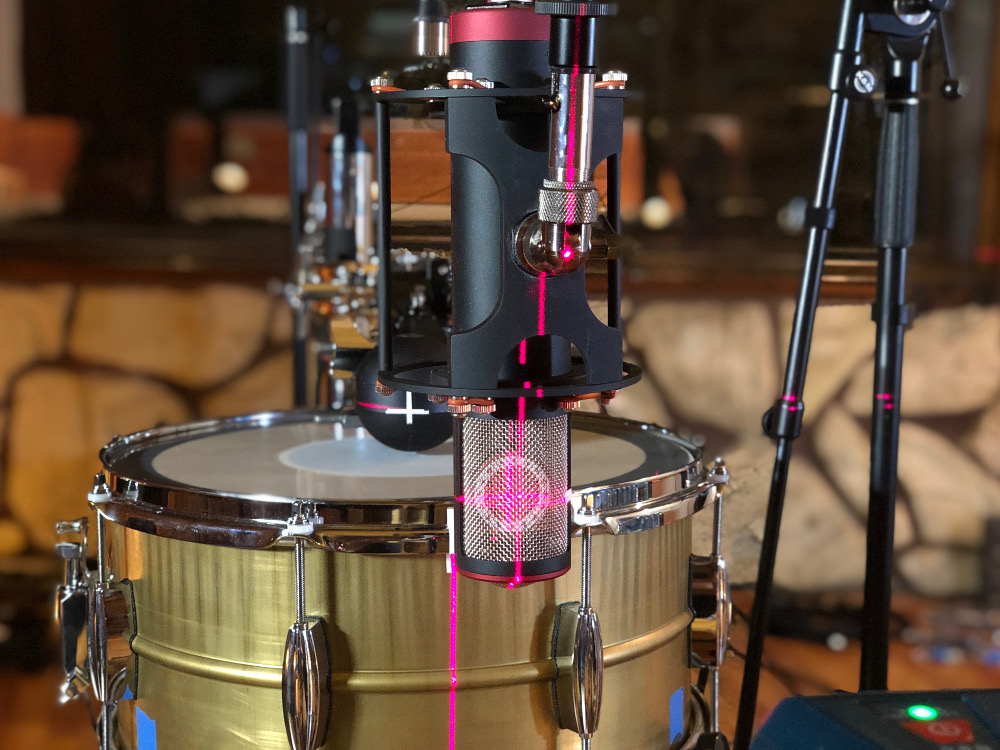
Right on target: Capturing unbiased comparisons on drums was among the myriad major hurdles that ATK had to clear.
“I am a completely different person than I was prior to starting Audio Test Kitchen nearly three years ago,” says Oana. “I’m totally fascinated by the entrepreneurial journey, and what it takes to make a startup. I became a student of startups via books, Audible, and podcasts, and if there’s a common thread among those teachings from people who have done it before, it’s that the main differentiating factor between people who achieve what they set out to do and those who don’t is resilience. When you’re taking on an endeavor to perhaps change the world, you will inevitably face lots of questions, decisions, points of inflection, and challenges.
“Through the periods of unknowns the only thing you really have to hold onto is your belief in the mission of what you’re doing, and your belief in yourself that you are potentially the right person to solve this problem. Because you’re going through this unknown territory, there is nothing and no one to tell you what is right and wrong, when you should keep going, what decisions to make. It can feel really scary at times and the only choice you have is to, at any given moment, decide to keep going or not.”
At that point, Oana would often have an experience not uncommon to Audio Warriors of every stripe–mixers and producers and engineers and artists who throw everything they’ve got at their craft, wondering all the while if light would indeed emerge at the end of the tunnel.
“It’s not until you put yourself in that unknown, unsupported territory that you can start to see a pattern,” he relates. “It’s a pattern of, ‘I’m going to have down days, but there’s going to be an up day.’ I would find myself on many days going, ‘I need a win, I need a win.’ Inevitably, a win would come, and it puts a little wind back in your sails and it solves a little problem. Maybe it’s as simple as getting a little nice feedback from somebody and you’re right back on that horse, fighting the battle, on the path again.
“But that whole thing, all the ups and downs, all the doubt and insecurity, the lack of a roadmap is just all part of it. No matter what you encounter if you want to complete your vision, if you want to get something done, if you want to change the world–you’ve got to just keep going.”
— David Weiss
Please note: When you buy products through links on this page, we may earn an affiliate commission.







